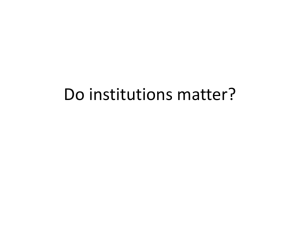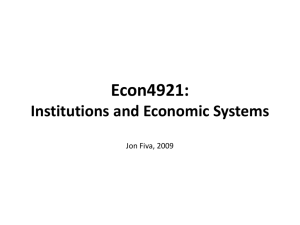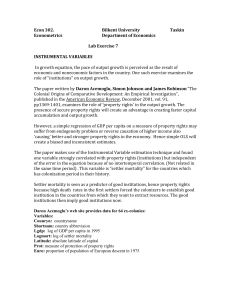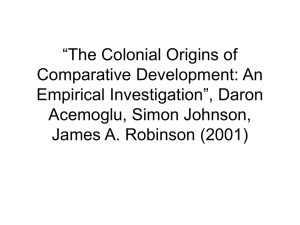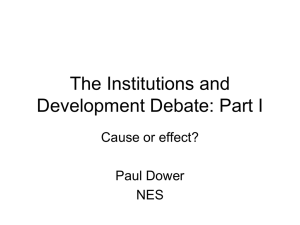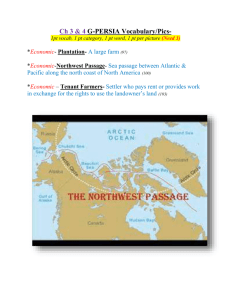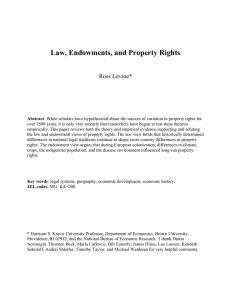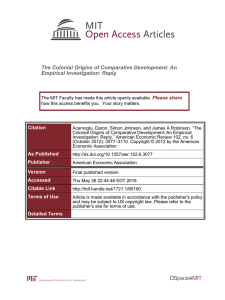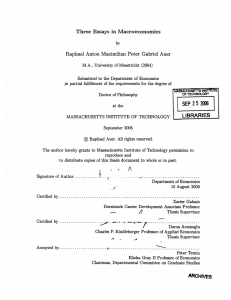Lecture2
advertisement
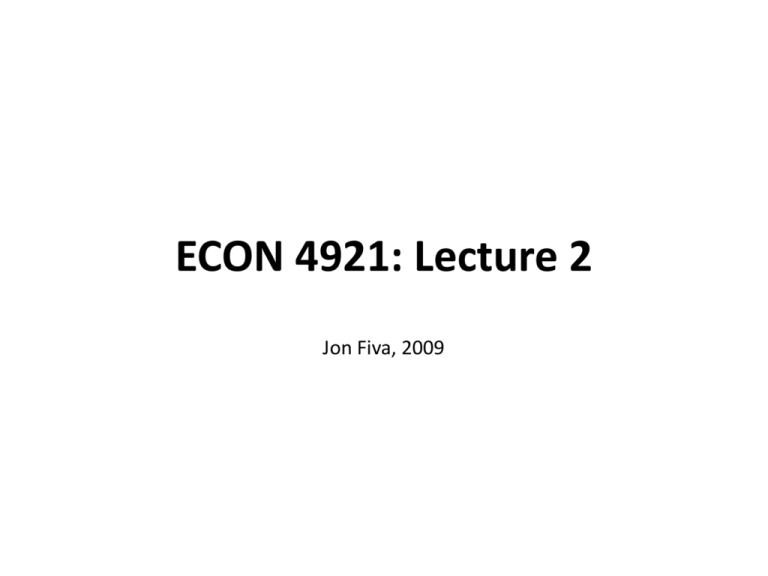
ECON 4921: Lecture 2 Jon Fiva, 2009 Institutions and economic performance • We are interested in establishing the causal effect of institutions on long run economic performance. • However, this is not straight forward: Correlation is not causation. • Institutions are endogenous to economic performance. – Causality runs both ways • E.g. poor countries lack the resources to build effective institutions – Omitted variable bias • Underlying conditions (e.g. geography, religion, history, culture) that lead to both institutions and economic performance. Possible Solution • Detour: The experimental ideal • In the absence of experimental data a possible solution is instrumental variable (IV) techniques. • Need a variable (z) that fulfill two criteria: – Relevance – Excludability Observables Unobservables Institutions Z Economic Performance The colonial experiment • In a similar fashion to HJ, AJR use European colonialism to isolate potential exogenous variation in current institutions. • Key difference between HJ and AJR identifying assumption: – Colonizer characteristics vs. conditions in colonies • Proposed Z : Settler mortality Observables Unobservables Institutions Settler Mortality (M) Economic Performance Settler mortality • In the tropics, 80 percent of European deaths were caused by malaria and yellow fever. – Europeans in Africa, India and Caribbean faced very high death rates. – But death rates for the adult local population were much lower (developed immunity). – Yellow fever in W. Africa was ’a strangers disease’. – … and had little effect on the health and economy of indigenous people. • Settler mortality = Mortality of soldiers, bishops and sailors between 17th and 19th century. AJR approach rests on three premises 1. Different types of colonization policies created different sets of institutions. • ’Extractive states’ e.g. Congo, Nigeria, Tunisia – – – • No protection of private property No checks and balances against government. Confiscatory taxation Neo-Europes, i.e. US, NZ, AUS. – – Protection of private property Law and order 2. Feasibility of settlements affected the probability of different sets of institutions. – – Do not argue that Eur. Influence in itself was positive or negative Exploit variation generated by local disease environment, proxied by Europeans’ mortality rates 3. Early institutions affect current institutions Reduced form show strong negative relationship between settler mortality and current economic performance. AJR interpretation: Reflects impact of settler mortality on current institutions Current institutions • Focus: property rights and checks against government power (’property rights institutions’) • Proxy for institutions: Protection from expropriation risks. – Vary from 0 to 10, for each country for each year. – AJR use average over 1985-1995 – Extractive state low value on this index. • Broad measure of property rights. • Data from Political Risk Services – Private company which assess the risk that foreign investment will be expropriated in different countiries. The equation of interest OLS • • Plain OLS estimates of eq (1) find a strong assocation between R and Y. Also when controlling for latitude and continent dummies. But this does not necessarily show a causal effect 1. 2. 3. 4. • Rich economies may prefer (or afford) better institutions Omitted variables Measure of institutions created ex post Attenuation bias (due to poor institution measure) Does this suggest an upward or downward bias in OLS? IV • Solution, treat R as an endogenous variable. • The first stage: • Isolate exogenous variation by using predicted values of R from first stage regression in the second stage. IV cont. • IV estimates suggest a large and statistically significant effect of institutions on national income. – Differences in institutions account for over 75% of the variation in income per capita today – Improving the institutions of Nigeria to the level of Chile would lead to a 7-fold increase in Nigeria’s income. • (in practice the difference is 11-fold) – No impact of geography, when institutions are treated as an endogenous variable • ”These results suggest that Africa is poorer than the rest of the world not because of pure geographic or cultural factors, but because of worse institutions” (p. 1372 AJR). IV cont. • Results robust to: – Different subsamples – Controlling for continent dummies, geography. – Controlling for current prevalence of malaria and life expectancy – Only using yellow fever as an instrument (eradicated today) Reversal of fortune • Many of the areas that were colonized in the tropical zone were richer and more densely populated in 1500 than the temperate areas later settled by Europeans. – • e.g. Mughals in India/Aztecs and Incas in Americas vs. North America, Australia. Proxy for pre-industrial income per capita : urbanization Source: Acemoglu et al. 2002, QJE Reversal of fortune cont. • Geography or culture can hardly explain the reversal • But AJR suggest: – Relatively rich places got worse institutions (’extractive’). – Relatively poor places, where colonizers settled in large numbers, got better institutions protecting property rights of a broad cross-section of society. – Can explain timing of reversal (19th century): When there are more investment opportunities, institutions should be more important. Main point • The work of AJR suggest that institutions are the fundamental cause of long run growth. – good institutions prevent the government or elite to extract rents from society. Unbundling institutions • AJR focus on property rights institutions, i.e. institutions constraining government and elite expropriation. • A closely related literature focus on contracting institutions, i.e. institutions supporting private contracts. – Several papers by Shleifer and co-authors (e.g. La Porta et al JPE1998, La Porta et al. JEL2008) – Main division: common vs. civil law – Colonial transplantation of the legal system • Acemoglu and Johnson (to be discussed at the seminar) aim to ’unbundle institutions’ • Main findings: – Weak contracting institutions do not have a negative effect on longrun economic performance, while property rights institutions do. Conditions in the colonies • A key aspect of AJR is that it is not the identity of the colonizer that matters, but conditions in the colonies. – Clearly depart from HJ where European influence in itself is deemed beneficial • Related to the work of Engerman and Sokolof (1997, 2000). – The Caribbean islands illustrate the adverse affects of Europeans, which set up repressive regimes based on slavery and forced labor. – Factor endowments such as geography, climate and soil conditions help explain the builings up of ’good institutions’ in nortern am. And ’poor institutions’ in Lat. Am. Paths of development • North am. Of relatively ”marginal econ. Interest compared with the extraordinary opportunities available in the Caribbean and Lat. am” (ES2000) • Haiti probably richest country in the world (on per cap basis) in 1790 • Puzzle: Why did US/CAN experience sustained econ. Growth in 18th and early 19th century? Factor endowments • Some econ. Historians have explained the divergence due to the identity of the colonizer. – But striking differences within the identity of the colonizer (e.g. US, Can vs. Barbados, Jamaica, e.g. Argentina vs Peru) calls for other explanation. • AJR explain the divergence as a result of institutions. • ES: Factor endowments (incl. Climate, soil, density of native population) – Predisposed North am. Colonies towards relatively equal distributions and corresponding institutions favoring a broad range of the population in commercial activity. • Suitable for grains and livestock no economics of scale Small family farms – Predisposed Lat. Am, Caribbean colonies to highly unequeal distributions and institutions that protected the elite. • Suitable for cultivating sugar and other highly valued commodities economics of scale extensive use of slaves, and the densely populated native population. Persistence • ”In those societies that began with extreme inequality, elites were better able to establish a legal framework that insured them disproportionate shares of political power, and to use that greater influence to establish rules, laws, and other government policies that advantaged members of the elite relative to non-members – contributing to persistence over time of the high degree of inequality”. (ES2000) • Inequality elite with strong political power institutions – E.g. consider the extension of franchise in North Am. Vs Lat. Am. Further reading • • • • Acemoglu, Johnson and Robinson 2002, QJE, Reversal of fortune: http://www.jstor.org/page/termsConfirm.jsp?redirectUri=/stable/pdfplus/4132478.pdf Engerman and Sokoloff 2000: http://www.jstor.org/view/08953309/di014723/01p02397/0 Rafael La Porta , Florencio López de Silanes, Andrei Shleifer , and Robert Vishny . "Law and Finance" Journal of Political Economy 106 (1998): 1113-1155. http://www.journals.uchicago.edu/cgi-bin/resolve?JPEv106p1113PDF Rafael La Porta , Florencio López de Silanes, Andrei Shleifer. ”The Economic Consequences of Legal Origin”, Journal of Economic Literature 46 (2008), 285-332 http://www.economics.harvard.edu/faculty/shleifer/files/consequences_JEL_final.pdf
